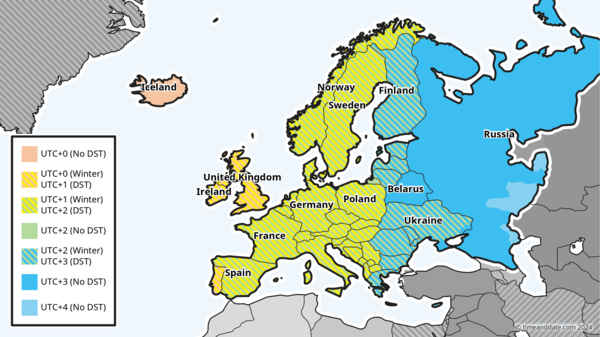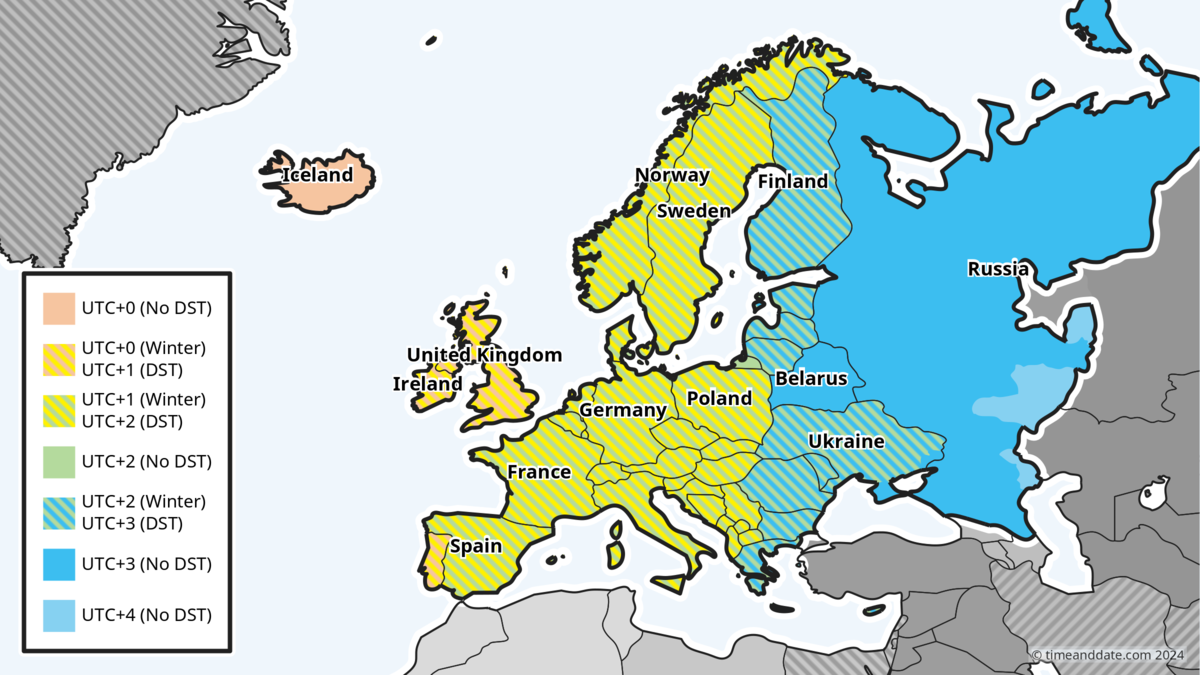Europe Ends DST 2024
On Sunday, October 27, 2024, clocks will be set back 1 hour in most of Europe as Daylight Saving Time (DST) ends. One country might opt out.


The striped areas on the map will change their clocks on October 27, 2024.
©timeanddate.com
When Do Clocks Change in Europe?
Clocks in most European countries are turned back by 1 hour at 01:00 UTC on October 27, 2024.
Since Europe spans several time zones, the switch from summer time to standard time (also known as winter time or normal time) occurs at different local times—see table further down.
DST in Europe starts again on Sunday, March 30, 2025, at 01:00 UTC.
28 Days Shorter than in the US and Canada
The US and Canada will end DST a week after Europe, on November 3, 2024.
In 2007, the United States implemented changes to “spring forward” earlier and “fall back” later. The Energy Policy Act of 2005, signed by President Bush, extended Daylight Saving Time to last 238 days.
Canada made similar changes to extend DST. By comparison, Daylight Saving Time in Europe lasts 210 days.
EU Effort to End DST Remains Deadlocked
In 2019, the European Parliament supported a proposal from the European Commission to eliminate DST in EU member countries. However, in 2021, the proposal stalled in the European Council because of practical concerns about implementing such a change.
Europe’s time zones and DST schedule
Possible Change in Ukraine
In July 2024, Ukraine’s parliament passed a law to eliminate the annual shift to DST. Although Ukraine is part of Europe, it is not a member of the European Union.
Until 2024, Ukraine has followed DST, with plans to move the clocks back one hour to Eastern European Time (EET), along with most European countries, on October 27.
However, under the new law, Ukraine would stay on EET year-round and no longer observe DST. There remains a possibility that the parliament's decision could be reversed. At the time of publishing this news story, the status of the new law is listed as “preparing for signature.”
Time Change in Europe
Time changes in Europe are synchronized. According to the current EU rules, DST starts on the last Sunday of March and ends on the last Sunday of October.
Participating countries are:
- The European Union (EU) including France, Germany, Spain, Italy, Poland, Sweden, and Bulgaria.
- Most other European countries, including the United Kingdom, Norway, and Switzerland.
Upcoming DST changes worldwide
European countries that do not have DST include Russia, Iceland, and Belarus.
DST End: European Local Times
| Time Zone during DST | Local Time of DST End | Time Zone after DST (standard time) |
|---|---|---|
British Summer Time (BST), used in the UK during summer. UTC offset: +1 hour | DST ends at 02:00 (2 am) local time. | UTC offset: None |
Irish Standard Time (IST), used in Ireland during summer. UTC offset: +1 hour | DST ends at 02:00 (2 am) local time. | UTC offset: None |
Western European Summer Time (WEST), observed in Portugal, the Faroe Islands, and the Canary Islands. UTC offset: +1 hour | DST ends at 02:00 (2 am) local time. | UTC offset: None |
Central European Summer Time (CEST), used in countries including France, Germany, Austria, Italy, Switzerland, Norway, Poland, Hungary, and Spain. UTC offset: +2 hours | DST ends at 03:00 (3 am) local time. | UTC offset: +1 hour |
Eastern European Summer Time (EEST), observed in countries including Bulgaria, Estonia, Finland, Greece, Latvia, Romania, and most areas in Ukraine. UTC offset: +3 hours | DST ends at 04:00 (4 am) local time. | UTC offset: +2 hours |
Most of the western parts of Russia and some parts of Ukraine are in the Moscow time zone, Moscow Standard Time (MSK). UTC offset: UTC +3 hours |